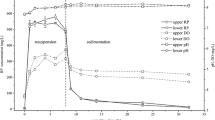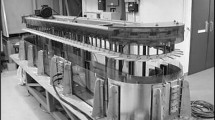Abstract
Sediment trap experiments were carried out 39 times during the years from 1977 to 1981 in Funka Bay, Hokkaido, Japan. The observed total particulate flux varies seasonally, that is, the particulate fluxes in winter and spring are larger than those in summer. The fluxes in all seasons increased with depth. Major components of settling particles are aluminosilicate in winter, biogenic silicate in spring and organic matter and terrestrial material in summer, respectively. The fluxes of each chemical component observed with sediment traps are normalized to that of Al by assuming that the actual flux of Al is equal to the accumulation rate onto the sediment surface. Vertical changes of the normalized flux of each chemical component indicate the following: Fe was not regenerated from the settling particles in the water column. Mn was regenerated from the settling particles in the lower layer exclusively between 80 m depth and the sediment surface. Cd was actively regenerated in the upper layer above 80 m depth. Phosphate was regenerated in the upper layer, while biogenic silicate was in the lower layer. The silicate regeneration, therefore, occurs after phosphate regeneration. The material decomposing in the water column below 40 m has an atomic ratio of P ∶ Si ∶ C = 1 ∶ 52 ∶ 128.
Similar content being viewed by others
References
Bruland, K. W. (1980): Oceanographic distributions of cadmium, zinc, nickel and copper in the North Pacific. Earth Planet. Sci. Lett.,47, 176–198.
Danielson, C. -G. (1980): Cadmium, cobalt, iron, lead, nickel and zinc in Indian Ocean water. Mar. Chem.,8, 199–215.
Honjo, S. (1982): Seasonality and interaction of biogenic and lithogenic particulate flux at the Panama Basin. Science,218, 883–884.
Honjo, S. and M. R. Roman (1978): Marine copepod fecal pellets: production, preservation and sedimentation. J. Mar. Res.,36, 45–57.
Hurd, D. C. (1973): Interactions of biogenic opal, sediment and seawater in the Central Equatorial Pacific. Geochim. Cosmochim. Acta,37, 2257–2282.
Maita, Y. (1982): Chemical environment of Funka Bay. Engan Kaiyo Kenkyu Note,19, 183–192 (in Japanese).
Matsumoto, E. and S. Togashi (1980): Sedimentation rates in Funka Bay, Hokkaido. J. Oceanogr. Soc. Japan,35, 261–267 (in Japanese).
Minoda, T. and A. Fuji (1982): Biological environment of Funka Bay. Engan Kaiyo Kenkyu Note,20, 94–105 (in Japanese).
Moor, R. M. (1978): The distribution of dissolved copper in the eastern Atlantic Ocean. Earth Planet. Sci. Lett.,41, 461–468.
Nakata, K. (1982): Species composition of phytoplankton community of Funka Bay in the spring bloom, 1981. Bull. Japan. Soc. Fish. Oceanogr.,41, 27–32.
Noriki, S., N. Ishimori, K. Harada and S. Tsunogai (1985): Removal of trace metals from sea water during phytoplankton bloom as studied with sediment traps in Funka Bay, Japan. Marine Chem. (in press).
Noriki, S., K. Nakanishi, T. Fukawa, M. Uematsu, T. Uchida and S. Tsunogai (1980): Use of a sealed teflon vessel for the decomposition followed by the determination of chemical constituents ofvarious marine samples. Bull. Fac. Fish. Hokkaido Univ.,31, 354–361 (in Japanese).
Ohtani, K. and K. Kido (1980): Oceanographic structure in Funka Bay. Bull. Fac. Fish. Hokkaido Univ.,31, 84–113 (in Japanese).
Tanaka, N., Y. Takeda and S. Tsunogai (1983): Biological effect on removal of Th-234, Po-210, and Pb-210 from surface water in Funka Bay, Japan. Geochim. Cosmochim. Acta,47, 1783–1790.
Tsunogai, S., K. Kido, Y. Nozaki and M. Minagawa (1974): A chemical study of the ocean, as studied in Funka Bay, Japan. 1) Oxygen ex- change across the air-sea interface, 2) Diffusive mixing and biochemical change. Paper presented at the spring meeting of Oceanogr. Soc. Japan, Tokyo, April, 1974.
Tsunogai, S. and M. Minagawa (1978): Settling model for the removal of insoluble chemical elements in sea water. Geochem. J.,12, 47–56.
Tsunogai, S. and N. Tanaka (1977): A study on Funka Bay sediments by the Pb-210 method. Proc. 1977 Meeting Hokkaido Branch. Soc. Jpn., Hakodate, p. 25 (in Japanese).
Tsunogai, S. and M. Uematsu (1978): Particulate manganese, iron and aluminum in coastal water, Funka Bay, Japan. Geochem. J.,12, 39–46.
Tsunogai, S., M. Uematsu, S. Noriki, N. Tanaka and M. Yamada (1982): Sediment trap experiment in the northern North Pacific: Undulation of settling particles. Geochem. J.,16, 129–147.
Tsunogai, S, M. Uematsu, N. Tanaka, K. Harada, E. Tanoue and N. Handa (1980): A sediment trap experiment in Funka Bay, Japan: “Upward flux” of particulate matter in seawater. Marine Chem.,9, 321–334.
Tsunogai, S., M. Uematsu, N. Tanaka and M. Minagawa (1977): Interim report on the trial of sediment trap experiment. Kaiyo Kagaku Kenkyu Note, No.4, 36–49 (in Japanese).
Tsunogai, S. and Y. Watanabe (1983): Role of dissolved silicate in the occurrence of a phytoplankton bloom. J. Oceanogr. Soc. Japan,39, 231–239.
Uematsu, M., M. Minagawa, H. Arita and S. Tsunogai (1978): Determination of dry weight of total suspended matter in seawater. Bull. Fac. Fish. Hokkaido Univ.,29, 164–172 (in Japanese).
Watanabe, Y and S. Tsunogai (1984): Adsorption-desorption control of phosphate in anoxic sediment of coastal sea, Funka Bay, Japan. Marine Chem. 15, 71–83.
Wiebe, P. H., S H. Boyd and C. Winget (1976): Particulate matter sinking to the deep-sea floor at 2000m in the Tongue of the Ocean, Bahamas, with a description of a new sedimentation trap. J. Mar. Res.,34, 341–354.
Yanada, M., Y. Maita and S. Fukase (1976): Seasonal variation of inorganic phosphate in Funka Bay and the the factors influencing the variation. Bull. Fac. Fish. Hokkaido Univ.,27, 160–171.
Author information
Authors and Affiliations
Rights and permissions
About this article
Cite this article
Noriki, S., Ishimori, N. & Tsunogai, S. Regeneration of chemical elements from settling particles collected by sediment trap in Funka Bay, Japan. Journal of the Oceanographical Society of Japan 41, 113–120 (1985). https://doi.org/10.1007/BF02109181
Received:
Revised:
Accepted:
Issue Date:
DOI: https://doi.org/10.1007/BF02109181




